| 1 | Pink-headed reed snake |
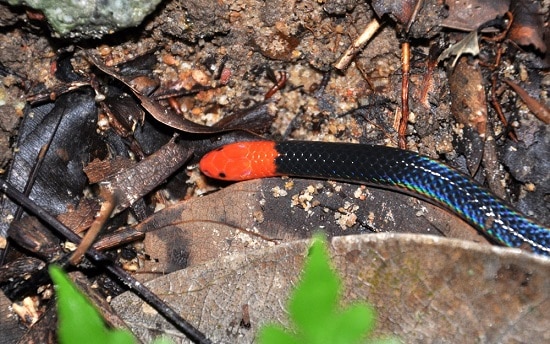
There are 3900 snakes worldwide, and many have evolved freaky powers that humans couldn’t dream of, regardless of their constantly advancing technology. Red-necked keelbacks blast sequestered toad toxins at people, while Burmese pythons can go 18 months without eating. One group, including the pink-headed reed snake, has evolved stunning iridescent scales which reflect every colour of the rainbow.
This snake lives in moist areas of Thailand and is ordinarily black on its body, with virtually no patterns. Its eyes are beady and black; only its head is a fabulous bright pink. Under the shine of a bright light, however, the formerly basic body explodes into a smorgasbord of colours. The pink-headed reed snake’s body dances with red, orange, yellow, blue, green, indigo and violet in constantly shifting patterns. Pictures don’t do justice, as you can’t see the colours shift and swirl until you’re there in person.
Aside from this iridescence, pink-headed reed snakes are fairly normal. They fall into the quiet, shy niche of snakes, sticking to forest clearings where they sit comfortably beneath leaf piles. The pink head is actually a venomous mimic, namely the Malaysian blue coral snake.
| 2 | Khaire’s black shieldtail |
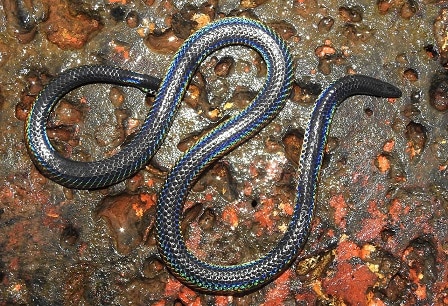
Melanophidium khairei, AKA Khaire’s black shieldtail, is an elusive Indian snake which was only discovered in 2016. It lives in the western Ghats of southern India, low rolling hills, at altitudes of between 510 and 780 metres. Being so rare, its diet and personality are barely known, but one fact everyone can understand is its mesmerising iridescent scales.
Melanophidium khairei is a shy snake, which sticks largely to one spot, explaining why it’s rarely seen. It’s a perfectly ordinary snake except that unlike 95%, it has rich, iridescent colours under a bright light. This species is simply pretending to be a dull grey to fly under the radar. The moment they’re struck with light, the truth is unmasked. Their disguise is ripped from their bodies and all their dazzling iridescent shades are laid bare.
This snake is apparently under pressure, with its forests being shredded for rubber plantations. It’s also vulnerable to becoming roadkill on the western Ghats’ many winding roads. Maybe the iridescence will save it – perhaps the flash of colour in response to headlights will alert people, and likewise for loggers wielding torches. This might be slightly idealistic.
Khaire’s black shieldtails have few defences against predators, humans included. Shieldtails lack a powerful venom, nor are they renowned for exceptional viciousness. Even Indian villagers rarely see this snake, although they doubtlessly know more than scientists from the UK. If you desire to see Melanophidium khairei, in all its iridescent glory, you’ll have to find it the hard way.
| 3 | Brown house snake |
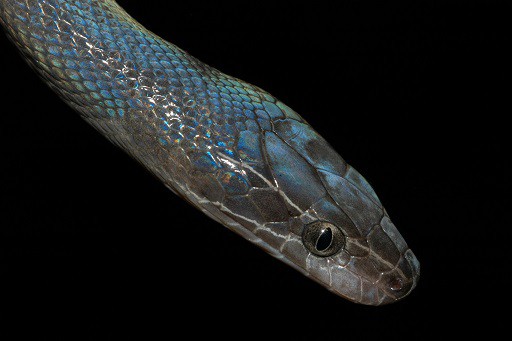
This African snake is simultaneously one of the dullest and most fabulous. In a normal light, they’re a basic brown-grey which no other snake could possibly be jealous of. The most interesting aspect is a large protruding eye. But under a bright torch, waves of light refract and generate dazzling rainbow colours.
Though not as stunning as the sunbeam snake, brown house snakes (a resident of South Africa) have the complete colour spectrum: red, orange and violet like all the rest. These colours seem to flow through their scales like currents of electricity, always changing position.
Brown house snakes (Boaedon fuliginosus) measure 60-120cm, and are one of the most widespread species in Africa. They inhabit urban areas comfortably, slithering up solid brick walls, and often invade houses in search of rodents. This species is capable of swallowing up an entire mouse nest in one sitting. They move by night, meaning that their usual dullness is a strong advantage, helping them to blend in. They’re perfectly safe around human beings, constricting prey using their immense muscular strength.
| 4 | Sunbeam snake |
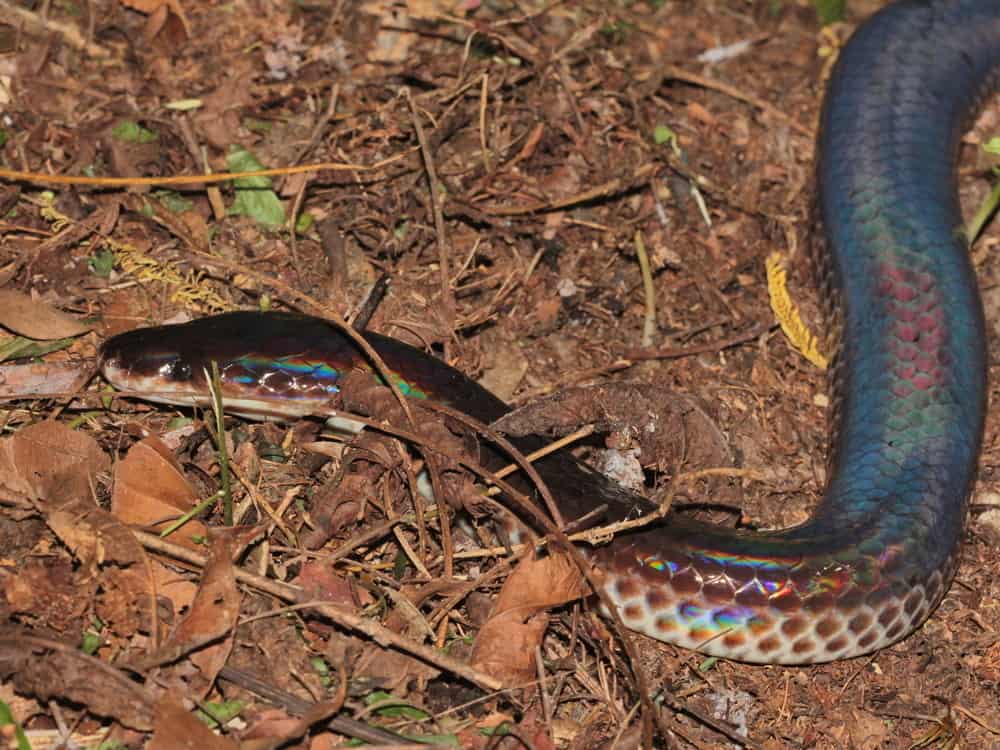
Perhaps the most iridescent snake of all. Sunbeam snakes live in Thailand, and vary in abundance. Sometimes they’re nowhere, but after heavy rains, they come out in force, particularly on footpaths adjacent to guava plantations or rice paddies.
Sunbeam snakes are normally a chocolate brown colour, with black eyes and round pupils. It only takes one bright light for iridescent scales to explode from every angle, vanishing the moment you remove the light. Early explorers were dazzled by the sunbeam snake’s light display, which led to the common name, and the Latin name: Xenopeltis unicolor.
Sunbeam snakes have the complete rainbow spectrum; there’s no being lazy and randomly skipping orange or indigo. It’s possible to witness this iridescent snake up close, as sunbeam snakes are exceptionally docile. You can pick them up and poke them (don’t do this) with no aggressive response. They normally cower in a ball of coils and protect their head, sometimes shaking their tail. Sunbeam snakes eat a varied diet, and can reach 100cm long.
| 5 | Formosan odd-scaled snake |
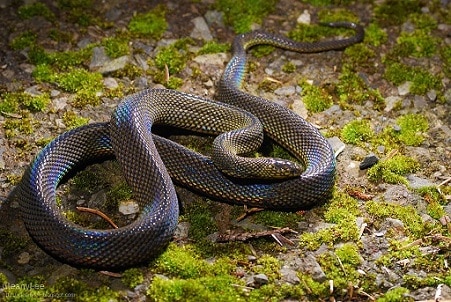
The resident iridescent serpent of Taiwan. For some snake enthusiasts, it’s all about venom and brutal fangs, the more the better, but this species is perfect for glitter devotees, those who love all things colourful. The Formosan odd-scaled snake (Achalinus formosanus) is mostly harmless to humans, with no ability or desire to kill. They’re thought to feed on earthworms, and prefer to stick below cover objects like rotting logs or bushes, within moist forests. In normal light, they’re brown to black, while under bright light, they shimmer with colour as though zapped with a paralysing ray gun.
Achalinus formosanus also occupies the southern Ryukyu islands of Japan. Nobody has conclusively explained why snakes became iridescent, but scaring off predators is likely. Animals instinctively assume that neon colours mean venom, and will abort their predatory mission the second they see them.
Coral snakes have permanent bright colours to scare predators without lifting a finger. But for species like Achalinus formosanus, it’s probably more advantageous to have murky colours the majority of the time. This maintains their camouflage, but opens up a sudden flash of dazzling colours as the predator reaches kill range, having seen through their initial deception shield.
| 6 | Underwood’s nocturnal treesnake |
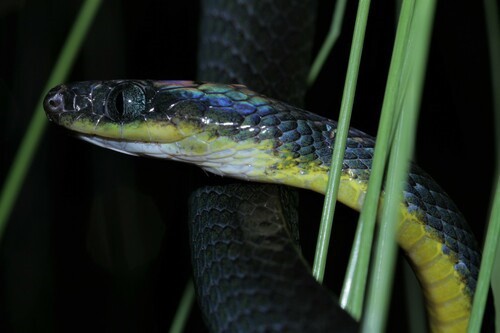
An iridescent snake of Nigeria and Ghana. This species coexists with ball pythons and black spitting cobras, but beats all three in the iridescent stakes. Underwood’s nocturnal tree snake (Dipsadoboa underwoodi) is a patient hunter which grinds along, eating treefrogs and skinks and never doing anything spectacular.
Dipsadoboa underwoodi rarely venture to human habitation, so you’ll have to stomp into the savannah to see them, maybe slipping out of a safari vehicle when the guide is distracted. It only takes a sweep of a torch for iridescent shades to appear from nowhere. The colours are very on-off; kill the light and the dullness will return as though it never left. Headlights and a smartphone are also ways to see this snake’s majestic iridescent colours.
Dipsadoboa underwoodi reach a maximum of 61cm, and have a yellow belly which gradually lightens towards the throat. They have a very mild venom and rely primarily on stealth for survival, stashing themselves in tree bark to stay hidden. Exactly what purpose the iridescence serves is unknown, but Underwood’s nocturnal treesnake is still here, relaxing in the tree clumps that it favours. Maybe iridescence was the secret sauce of survival, or maybe it was irrelevant, an evolutionary leftover which no longer serves a purpose.
| 7 | Bocourt’s watersnake |
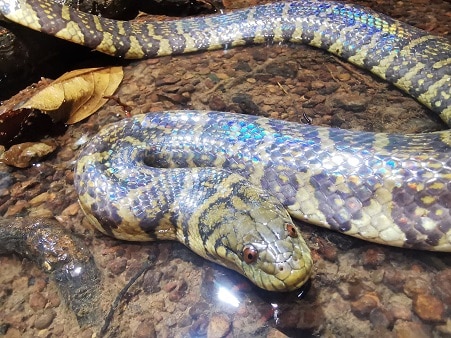
This iridescent snake lives in swamps and streams of Vietnam. Their diet consists of frogs with a small helping of fish, and they’re happy to wallow aimlessly in water for long periods of time. Bocourt’s watersnake is defeated horribly by the king cobra in both venom and size, yet is superior for its iridescent sheen.
King cobras are a duller beige, while Bocourt’s watersnake already has appealing patterns, and can dazzle people with red, blue, or violet depending on the angle. As usual, their iridescent colours burst to life under the shine of a light, whether a torch or a desperately lit campfire. Bocourt’s watersnakes are the only member of their family, and average at 100cm, with a thick body and a head barely distinct from their neck.
This species has silly looking red eyes, which seem to have been stitched onto its head. These are oriented upwards to enable its swampy lifestyle. A lot of iridescent snakes are normally dull, but Bocourt’s snake is colourful in any case. Bocourt’s watersnakes are peaceful and very unlikely to sneak up on you as you establish camp for the night.
| 8 | Hoffman’s earth snake |
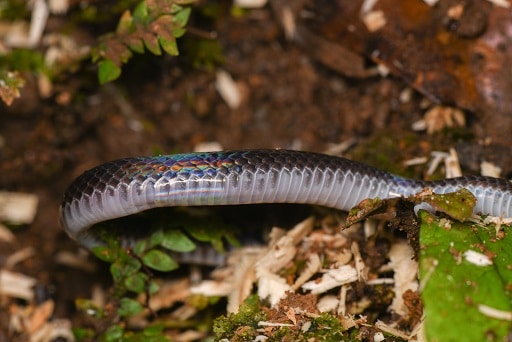
An iridescent snake of Costa Rica, measuring 30cm. Hoffman’s earth snake has smooth, shiny scales. These allow two characteristics: 1) gliding through soil smoothly, and 2) reflecting every colour of the rainbow in dazzling light rays.
This is a peaceful snake which lives in forests and gardens alike (requiring soft soils), but barely looks beyond its soil tunnels. Hoffman’s earth snakes have tiny, beady eyes, and have a chocolate brown body with a white belly. Pictures may be misleading, making explorers think it’s just another boring burrowing snake, until they arrive and realise that it’s far more. Hoffman’s earth snakes simply dig through soil using their slender snouts, until they find small slimy creatures worthy of eating, such as earthworms and slugs.
Like the sunbeam snake, Hoffman’s earth snake is extremely docile, and rarely bites even if provoked. In fact, a disproportionate amount of these iridescent snakes are completely non-threatening. This could be a clue as to why the characteristic evolved, that it was likely for stealth or trickery, in some way, with offense being ruled out. The majority of these snakes aren’t related either. Iridescence isn’t a characteristic specific to one family. It’s dormant in many, and certain circumstances can bring it to the surface (yet to be pinpointed).
| 9 | White-lipped python |
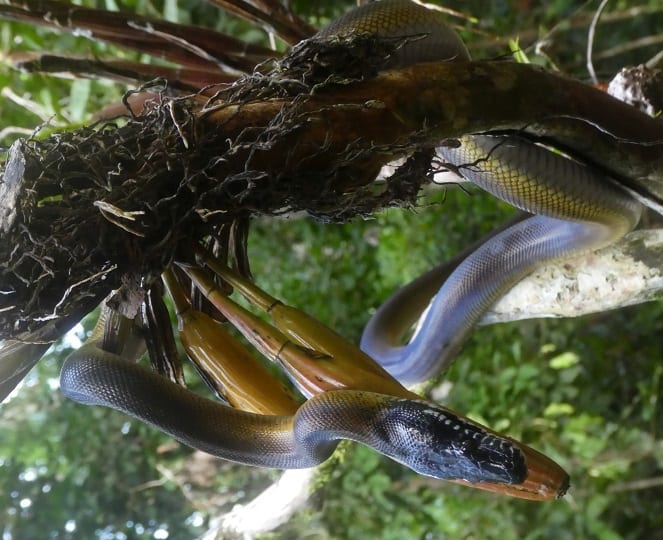
The white-lipped python lives in forests of New Guinea, and is most likely to be seen on the ground near streams. There’s no logical reason for this species to have dazzling iridescent colours, yet it does anyway. The white light of a torch can be transformed into red, indigo or blue when it strikes this harmless snake’s scales.
The white-lipped python (Leiopython albertisii) is a constrictor which feeds on birds and mammals, slithering along the forest floor while flecking its tongue to pick up microscopic scent particles. The white-lipped python’s sense of smell far outstrips our own, and so do its fabulous colours, even if they don’t know how to pilot a battleship like we do.
White-lipped pythons are dark grey the majority of the time, with their only real patterns being the signature white bars below the mouth. Their pupils are vertical and their irises are sooty grey. Like the rest, they possess every colour of the rainbow under a bright light, which shift and swirl depending on the angle you shine them at.
| 10 | Brazilian rainbow boa |
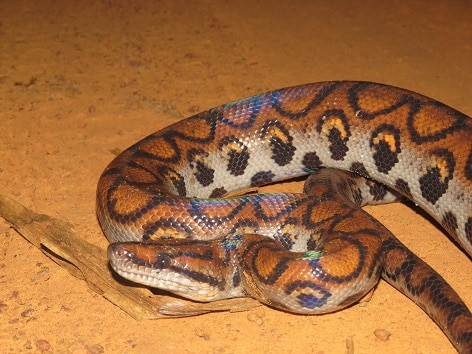
In normal light, the Brazilian rainbow boa is already a colourful snake, with orange and black overlapping in vivid circles. They have vertical pupils with a honey-coloured iris, and a relatively narrow head. This snake is closely related to the Columbian rainbow boa, which is plainer but also has an iridescent sheen. Both are extremely popular in captivity due to their lack of fuss about their diet.
This is a 1-1.8 metre species of Central America, ranging from Ecuador to the Atlantic coast of Brazil. Compared to the rest, this snake looks particularly oblivious to its fancy colours, like it’s confused as to why anyone would admire it. Rainbow boas have smooth scales to run your finger down, and are effective at weaving through gnarly undergrowth where other snakes might get stuck.
This species is as instantly iridescent as the rest of our list. After shining a torch on their body, there’s no 5 second delay with an alien shimmering sound; the iridescent shades appear instantaneously. Brazilian rainbow boas are relatively peaceful, and can be viewed safely once their rainbow colours manifest. Finding one to stare at isn’t difficult; your local pet shop might have one in stock right now.
